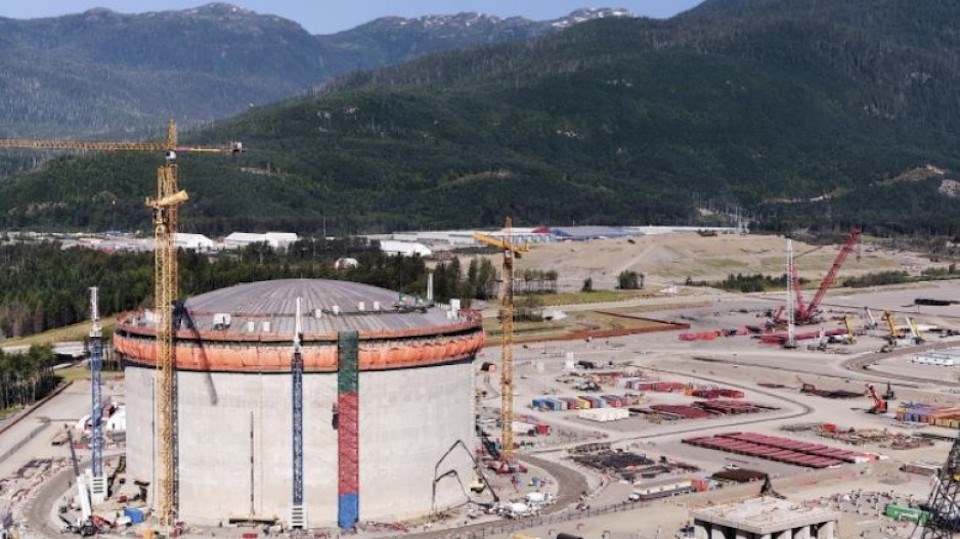With its unsettled aboriginal title issues and sometimes sclerotic regulatory process, B.C. has been described as a place where it’s hard to get anything built.
But the largest single private sector investment in Canadian history, the $17 billion LNG Canada project ($40 billion, when upstream assets and the associated Coastal GasLink pipeline are included), continues to rise from the ground in Kitimat and is past the 50 per cent completion stage.
The project is a testament to the fact things can get built in B.C., so long as the proponent has deep pockets, has ticked all the environmental and social licence boxes and has the support of First Nations.
“We had an extremely busy year in 2021,” LNG Canada CEO Peter Zebedee said in a fireside chat today, along with Haisla First Nation Chief Crystal Smith, at the final day of the three-day BC Natural Resources Forum. “We were able to reach some really key milestones.”
Roughly 4,000 people were employed in 2021 at the Kitimat site. Zebedee said this year will be even busier.
“This is going to be the most intensive period of time for construction on the project,” Zebedee said. “We call it our year of going into high gear. We’re really going to be accelerating our pace of project completion and construction.
“We've got thousands of Canadians right now working on the project site. Most of them are from B.C. and includes many folks from the Haisla Nation and from the Indigenous communities around the project.”
He added the company has spent $3.5 billion on contracts and procurement in B.C., of which $2.6 billion of which was awarded to First Nations and local area businesses.
When the liquefied natural gas plant goes into production in about three years from now, the LNG exported to Asia will have the potential to significantly reduce greenhouse gas emissions, if it is used to displace coal power.
“That energy shipped from LNG Canada over to Asia is going to offset up to 90 million tonnes of CO2 emissions in a single year,” Zebedee said. “It’s the equivalent of shutting down 40 to 60 coal fired plants in China. It is the entire emissions footprint of British Columbia today.”
The project’s associated natural gas pipeline – Coastal GasLink – continues to be assailed by the hereditary chiefs of the Wet’suwet’en, although elected Wet’suwet’en chiefs and councils support the project. The CGL project has experienced numerous blockades and protests, which have delayed progress and resulted in numerous arrests.
Relations with First Nations in Kitimat and area, where the LNG plant is being built, is a very different story.
The Haisla First Nation have been critical to the project moving ahead, and are now parlaying their expertise and relationships with industry to move forward on their own LNG project – Cedar LNG – in partnership with Pembina Pipelines Corp. (TSX:PPL). It is currently in the B.C. environmental review process.
“It was one thing to provide that support and to work with LNG Canada, and now we're implementing what we learned with that process for our own project,” said Smith, who chairs the First Nations LNG Alliance.
The Haisla are also now focused on extending contracts awarded to the Haisla for construction to the post-construction phase – plant operations.
“Right now, we’re looking to establish our planning around the maintenance contracts – extending the employment opportunities well into operations,” Smith said.
Smith talked about how partnering with industry has helped raise the standard of living for the Haisla’s 1,800 members and provided their own source of revenue.
“We’re constructing an apartment complex on reserve,” Smith said. “We were able to purchase eight buildings within the municipality of Kitimat to provide affordable housing to our members. And … for the first time in our nation’s history, we have a culture and language department, where their sole mandate is to preserve what’s existing and be able to have that learning opportunity for future generations.”
Smith added other neighbouring First Nations are also benefitting from the LNG Canada construction project.
“I actually went for a site visit last month, where we toured on the bus, where I was able to see not only our nation's logo, but I was able to see logos from Gitgaat, from Gitxaala,” Smith said. “There’s companies that are partnered with Kitselas.
“These relationships that have been established by other First Nations, (who) are working in our territory, are providing benefit just as much as we’re getting benefit from those relationships.”
LNG Canada is a joint venture involving Royal Dutch Shell, PETRONAS, PetroChina, Mitsubishi and KOGAS. The joint venture aims to be exporting LNG from B.C. by 2025.
It would have an annual export capacity of 13 million tonnes of liquefied natural gas for its first phase, though that would double to 26 million tonnes annually, if a second phase expansion is sanctioned and approved.



